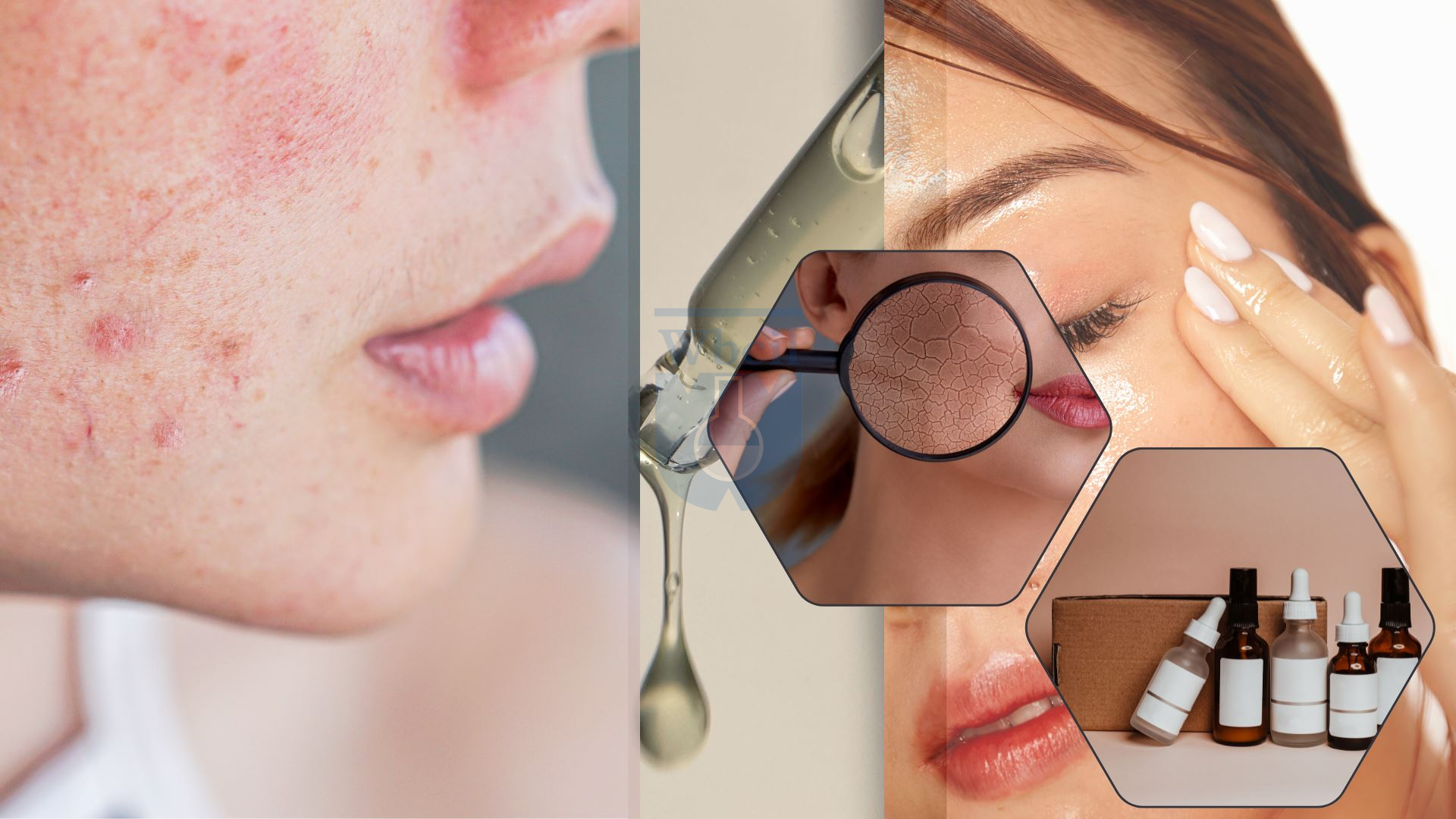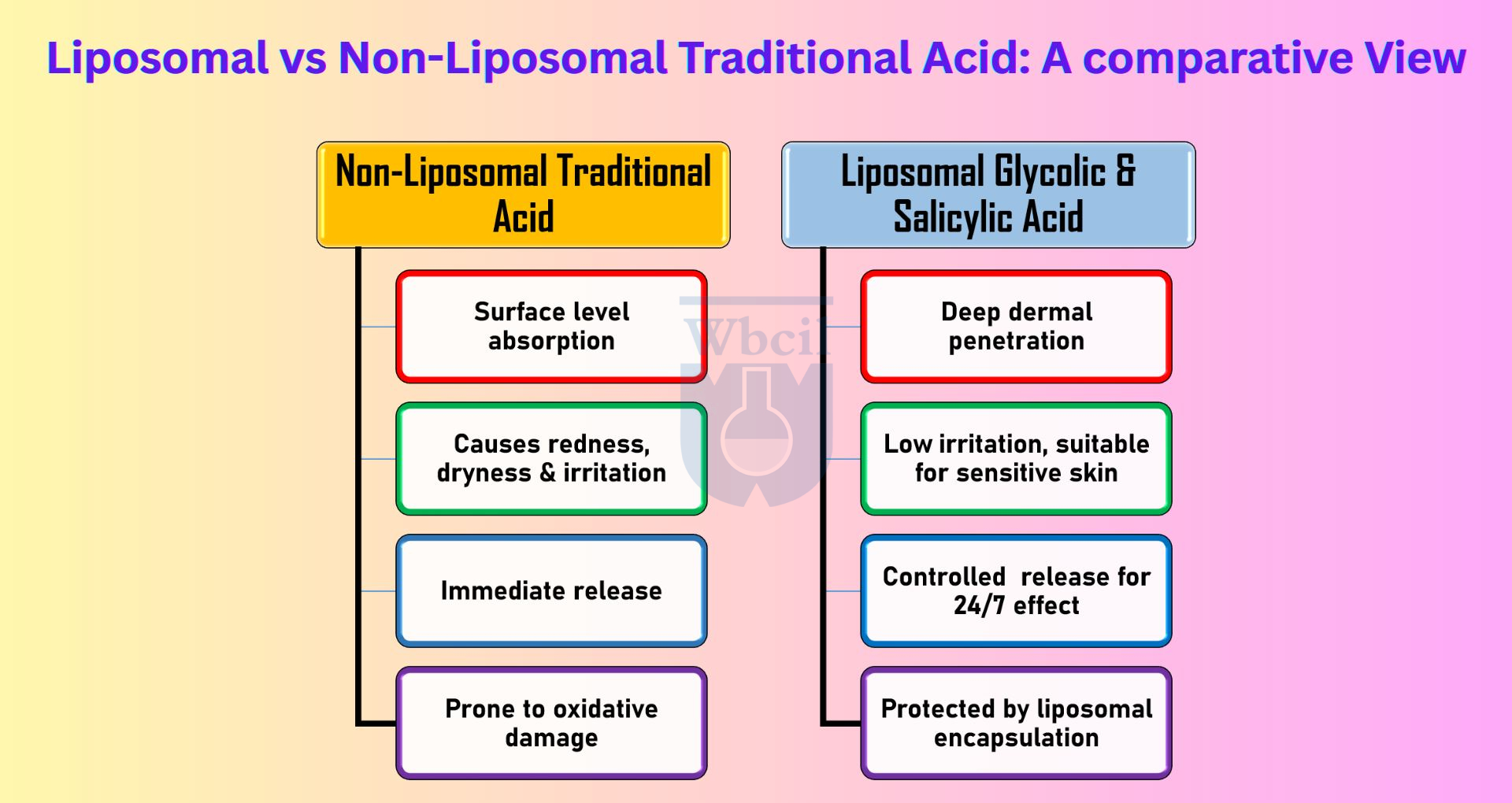Global Ingredient Watch: The Surge in Liposomal Glycolic & Salicylic Acids in Acne and Renewal Solutions
Acne is a persistent skincare challenge, but what if the solution could be smarter, faster, and more effective? Liposomal glycolic acid and salicylic acid are revolutionizing acne and skin renewal solutions, offering a new way to tackle these problems with precision and power.
A Global Shift in Skincare Innovation
As the demand for targeted, safe treatments skyrockets, liposomal actives are quickly becoming the preferred choice for today’s savvy consumers. These cutting-edge ingredients are rewriting the rules of skincare, offering smarter, gentler, and more effective solutions than traditional acids.
Gone are the days of harsh exfoliants that strip and irritate your skin. With liposomal technology, these active ingredients are encapsulated and delivered deep into your skin, where they work their magic for smoother, clearer, and healthier skin.
In this blog, we’ll uncover the science behind liposomal glycolic and salicylic acids, explore the market trends fueling their rise, and show how formulators can take advantage of these groundbreaking actives to craft the next generation of skincare products.
Ready to experience the future of exfoliation and acne care? Let’s dive into how liposomal acids are setting a new standard in the skincare world!
What Are Liposomal Acids? A Delivery Revolution
Liposomes are microscopic vesicles that replicate the skin’s natural cell membrane. Liposomal encapsulation involves enclosing active ingredients, such as glycolic and salicylic acids, within the phospholipid spheres, offering protection and enhanced delivery.
This encapsulation allows acids to penetrate deeper into the skin, targeting the cellular layers where they can work most effectively. Unlike non-liposomal acids, which often degrade quickly and can irritate the skin’s surface, liposomal acids are protected, offering controlled, time-released benefits.
The result? More stable, longer-lasting action with minimal irritation, making them ideal for sensitive skin and high-performance formulations.
Whether in serums, masks, or overnight treatments, liposomal acids are gaining a reputation as the best exfoliants for acne-prone sensitive skin, taking skincare to the next level.

Liposomal Glycolic Acid –Gentle Exfoliation Without Irritation
-
Role of Glycolic Acid in Skin Renewal, Hyperpigmentation, and Dullness:
- Renews Skin- Glycolic acid, an alpha hydroxy acid (AHA), accelerates the skin’s natural exfoliation process, helping to slough off dead skin cells from the surface, revealing fresher, younger-looking skin [1].
- Fights Acne & Hyperpigmentation– It is particularly effective in treating post-inflammatory hyperpigmentation, as it can break down the bonds between skin cells and lighten dark spots, acne scars, skin blemishes and age spots [2].
- Addresses dullness– Glycolic acid helps to promote a healthy skin cell turnover, resulting in a brighter, more radiant complexion [3].
-
Issues with Traditional Glycolic Acid:
- While glycolic acid is widely used, traditional formulations can often lead to irritation, particularly for sensitive skin. Common side effects include burning sensations, dryness, and barrier damage due to the acid’s potent exfoliating action [1].
- The immediate release of glycolic acid can be harsh on the skin, especially if used in higher concentrations, leading to visible peeling and discomfort [1].
-
How Liposomal Encapsulation Helps:
- Slow release & Reduced irritation: Microencapsulation ensures gradual glycolic acid release, promoting pH-balanced exfoliation, minimizing irritation and offering smoother application [4].
- Sensitive skin exfoliant: Liposomes ensure transepidermal delivery of glycolic acid, promoting a uniform and even skin tone while reducing visible flaking by gentle exfoliation [4].
- Stimulates collagen without surface trauma: Liposomal glycolic acid boosts collagen synthesis deep within the skin, promoting barrier repair, enhancing firmness and elasticity without peeling or irritation [5].
-
Benefits of Liposomal Glycolic Acid in Serums, Toners, Peels, and Overnight Treatments:
Liposomal glycolic acid Serum is perfect for resurfacing serums, toners and overnight treatments due to its gentle yet effective action. Its ability to work overnight while minimizing irritation makes it an ideal skin renewal solution, delivering noticeable results with minimal discomfort.
Liposomal Salicylic Acid (SA) – Controlled Release for Smarter and Safer Acne Treatment
-
Role of Salicylic Acid in Acne, Oily Skin, and Clogged Pores:
- Anti-Acne- Salicylic acid is a beta hydroxy acid (BHA) that penetrates deeply into the skin, helping to break down oil and debris within clogged pores, making it highly effective for treating acne and blackheads [6].
- Exfoliation– It helps to exfoliate the skin’s surface, clearing dead skin cells and preventing the formation of new acne lesions [7].
- Oil Balance– It’s also known for balancing oil production, a key factor in oily and acne-prone skin [8].
Lu et al. investigated the anti-acne properties of Salicylic Acid in human SEB-1 sebocytes.
They observed that treatment with salicylic acid significantly decreased sebocyte lipogenesis by downregulating the adenosine monophosphate-activated protein kinase (AMPK)/sterol response element-binding protein-1 (SREBP-1) pathway and reduced inflammation by suppressing the NF-κB pathway in these cells. Salicylic acid also induced apoptosis via extrinsic pathway in SEB-1. Subsequently, application of SA for three weeks suppressed the levels of cytokines and major pathogenic proteins around acne lesions [8].
-
Drawbacks of Traditional Salicylic Acid:
- Traditional salicylic acid can often lead to overdrying, irritation, and inflammation due to its potent exfoliating properties.
- While effective at clearing pores, it can strip the skin of essential moisture, leading to a compromised skin barrier.
- This excessive dryness and irritation may cause further breakouts or exacerbate existing skin issues, making it difficult for sensitive skin types to tolerate.
-
Liposomal Salicylic Acid Advantages:
- Deep pore delivery with less irritation: Liposomal encapsulation allows for deeper penetration of salicylic acid into the pores while ensuring controlled release, reducing the likelihood of irritation and dryness [5, 9].
- Sustained anti-inflammatory action: Liposomal salicylic acid provides a longer-lasting anti-inflammatory effect, reducing swelling and redness associated with acne while preventing future flare-ups [5, 9].
- Supports microbiome balance: Unlike traditional formulations that may disrupt the skin’s natural microbiome, liposomal salicylic acid helps to maintain a healthy balance of skin bacteria, which is essential for acne prevention and overall skin health.
-
Ideal for Leave-On Acne Products, Masks, Spot Correctors:
Due to its controlled release and gentle action, liposomal salicylic acid is perfect for leave-on acne treatments, spot correctors, and masks. It allows for sustained, effective acne treatment throughout the day or night without harsh side effects, making it a better choice for those with sensitive or reactive skin.

Why Liposomal Formulations Are Winning Globally
- Growing Demand for Dermatologist-Backed, Gentle Products: Consumers are choosing dermatologist-approved products that are both effective and gentle, and liposomal formulations, with their deep dermal penetration and minimal irritation, are perfect for sensitive skin.
- Rise of Tech-Enhanced Skincare: Liposomes and nano-encapsulation are tech-driven formulas that are setting new standards in the cosmetic industry by offering an effective solution to all major skincare problems
- Global Expansion in Dermocosmetics: Liposomal formulations are seeing rapid adoption in APAC, EU, and the US, gaining traction in the dermocosmetic market for their safe and effective ingredient delivery.
- Liposomal Acids for Sensitized Skin: Liposomal acids, by offering gentle exfoliation and skin renewal, are great alternatives to the harsh exfoliants available in the market.
- Clean Label Advantage: Liposomal formulations attract consumers who value transparency and natural skincare by offering clean-label ingredients, i.e., free from harmful additives and preservatives.
WBCIL’s Liposomal Acid APIs: Clean, Stable, High-Performance
- Clean-Label: Cutting-edge actives, free from harmful additives, providing transparency and purity for superior skincare results
- Stable & Pharma-Grade: High-quality, stable ingredients designed for maximum efficacy
- Customizable Formats: Suitable for leave-on treatments or rinse-off
- WHO-GMP Certified: Ensuring the highest standards of quality and safety
- Formulation Support: Expert assistance available to help create tailored skincare solutions
The Future of Exfoliation Is Encapsulated
Liposomal acids are the future of acne and skin renewal solutions, offering safer, smarter, and more inclusive formulations. By encapsulating active ingredients, liposomes provide a gentle yet effective way to deliver powerful skincare benefits without harsh side effects, making them suitable for a wider range of skin types.
These formulations appeal to both efficacy-focused and skin-sensitive markets. Liposomal acids enhance ingredient absorption for maximum results while minimizing irritation, making them perfect for those seeking effective treatments without compromising skin health.
For formulators, WBCIL’s pharma-grade liposomal glycolic acid and salicylic acid offer an exciting opportunity to create the next generation of skincare. With proven expertise, WBCIL provides high-performance liposomal exfoliating actives that meet the demand for both effective and gentle acne and skin renewal solutions and provide high-bioavailability exfoliant ingredients.
- Tang, S. C., & Yang, J. H. (2018). Dual Effects of Alpha-Hydroxy Acids on the Skin. Molecules (Basel, Switzerland), 23(4), 863. https://doi.org/10.3390/molecules23040863
- Houshmand E. B. (2021). Effect of glycolic acid, phytic acid, soothing complex containing Emulsion on Hyperpigmentation and skin luminosity: A clinical evaluation. Journal of cosmetic dermatology, 20(3), 776–780. https://doi.org/10.1111/jocd.13950
- Babilas, P., Knie, U., & Abels, C. (2012). Cosmetic and dermatologic use of alpha hydroxy acids. Journal der Deutschen Dermatologischen Gesellschaft = Journal of the German Society of Dermatology : JDDG, 10(7), 488–491. https://doi.org/10.1111/j.1610-0387.2012.07939.x
- Moghimipour, E., Gorji, A., Yaghoobi, R., Salimi, A., Latifi, M., Aghakouchakzadeh, M., & Handali, S. (2024). Clinical evaluation of liposome-based gel formulation containing glycolic acid for the treatment of photodamaged skin. Journal of drug targeting, 32(1), 74–79. https://doi.org/10.1080/1061186X.2023.2288998
- Rahimpour, Y., & Hamishehkar, H. (2012). Liposomes in cosmeceutics. Expert opinion on drug delivery, 9(4), 443–455. https://doi.org/10.1517/17425247.2012.666968
- Grimes P. E. (1999). The safety and efficacy of salicylic acid chemical peels in darker racial-ethnic groups. Dermatologic surgery : official publication for American Society for Dermatologic Surgery [et al.], 25(1), 18–22. https://doi.org/10.1046/j.1524-4725.1999.08145.x
- Alpha Hydroxy Acids | FDA
- Lu, J., Cong, T., Wen, X., Li, X., Du, D., He, G., & Jiang, X. (2019). Salicylic acid treats acne vulgaris by suppressing AMPK/SREBP1 pathway in sebocytes. Experimental dermatology, 28(7), 786–794. https://doi.org/10.1111/exd.13934
- Bhalerao, S. S., & Harshal, A. R. (2003). Preparation, Optimization, Characterization, and stability studies of salicylic acid liposomes. Drug Development and Industrial Pharmacy, 29(4), 451–467. https://doi.org/10.1081/ddc-120018380
Liposomal glycolic and salicylic acids are encapsulated in lipid spheres, which allow for deeper penetration and controlled release. This ensures better absorption, reduced irritation, and enhanced effectiveness, making them gentler yet more powerful than traditional acids.
Liposomal acids deliver active ingredients deeper into the skin, targeting clogged pores and reducing inflammation more effectively than traditional formulations. Their slow, sustained release minimizes irritation while providing long-lasting results.
Yes, liposomal glycolic and salicylic acids are ideal for sensitive skin. The liposomal encapsulation ensures gentle exfoliation and controlled release, reducing the risk of irritation, dryness, and redness typically associated with traditional acids.
Both acids promote cell turnover, helping to shed dead skin cells, reduce hyperpigmentation, and improve overall texture. Liposomal delivery systems ensure deeper penetration for more effective skin renewal and collagen stimulation.
Yes, liposomal glycolic and salicylic acids are perfect for daily skincare routines, especially when included in serums or creams. Their controlled release allows for gentle daily exfoliation without the harsh side effects of traditional exfoliants.
Liposomal glycolic and salicylic acids are becoming the industry standard for acne treatment and skin renewal. Their ability to provide gentle, long-lasting results with minimal irritation makes them highly desirable for both sensitive and oily skin types.
Yes, these liposomal acids are effective in reducing hyperpigmentation and lightening acne scars. Their deeper penetration allows them to address skin discoloration and uneven texture, promoting a smoother, more even skin tone.
WBCIL has launched a complete range of creams & serums, including liposomal Vitamin C & E Niacinamide, Hyaluronic Acid, Glycolic Acid, Salicylic Acid and Alpha-lipoic Acid. It also manufactures liposomal minerals like calcium, iron, magnesium etc.
WBCIL is committed to continuous research and development, focusing on:
- Innovative Formulations: Developing next-generation liposomal products to meet evolving consumer needs.
- Quality Assurance: Adhering to stringent quality control measures to ensure product efficacy and safety.
- Global Expansion: Strengthening its presence in international markets through strategic partnerships and collaborations.
